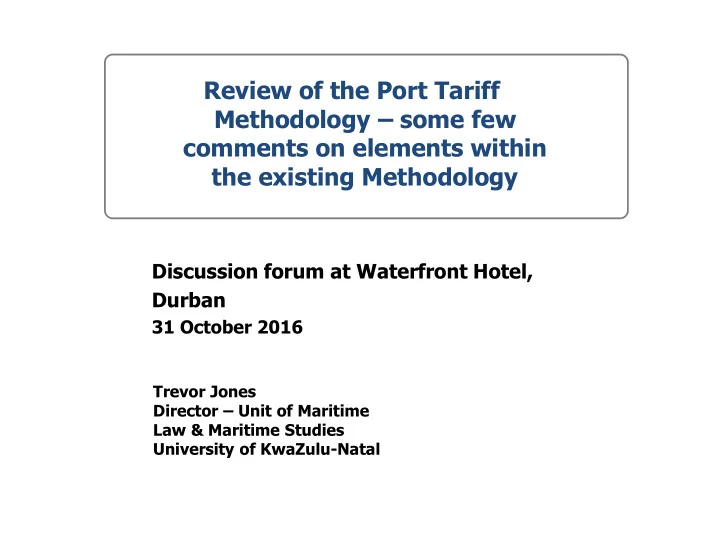

Review of the Port Tariff Methodology – some few comments on elements within the existing Methodology Discussion forum at Waterfront Hotel, Durban 31 October 2016 Trevor Jones Director – Unit of Maritime Law & Maritime Studies University of KwaZulu-Natal
Charting the way forward Very brief outline – three areas of concern • Estimation of the Regulatory Asset Base (RAB) o Difficulty of valuation of port assets, notably assets associated with heavy infrastructure o Cost of the initial acquisition of certain assets o Longevity of key infrastructural assets • Appropriate measure of the Authority’s exposure to market (non-diversifiable) risk – the β • Inclusion of a Claw-back (or give-back) mechanism o Disincentivisation of efficiency and performance improvements
Charting the way forward The Regulatory Asset Base (RAB) RAB = v – (d + w) where v = value of the assets used d = depreciation w = working capital Main concern is with “v”, notably: • Difficulty of establishing appropriate values for certain assets – Heavy marine infrastructure (fairways, breakwaters, etc.) – Basic cargo-working infrastructure – Tugs, dredgers and even pilots (maybe much easier) • How (if at all) is this affected by the cost of the initial acquisition of the assets? Implication if zero initial cost? Simple example: the value of the approach channel, breakwaters and internal channels in East London? …or in Ngqura??
A bit more history The TNPA’s exposure to market risk – the β Context A state-owned monopoly facing very limited regional inter-port competition (and insulated from the effects of such through the Claw-back?) • Clearly substantially < traded firms • Comparators from international public entities? • Case for a β of zero (SAASOA, SAAFF position)? • β ~ 0.3(Martin)? (Perhaps trivial) example: The doubling of berth capacity for bunker barges at Island View 10 in Durban, and the resultant proposed bunker levy…
A bit more history The Claw-back mechanism A built-in disincentive for efficiency, productivity gains? Mitigated by proper implementation of TOPS, MOPS etc.? • Challenging for intra-Transnet relations? • Qui custodet custodes? Easier if the Authority established independently outside Transnet in line with the Act Thank you..
Recommend
More recommend